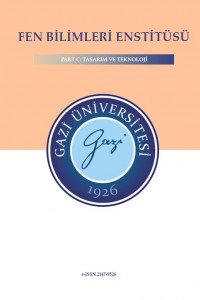Tepki yüzeyi metodolojisi kullanılarak nanokompozitin delinmesinde oluşan itme kuvvetinin modellenmesi ve analizi
Abstract
Bu
çalışmada, cam elyaf takviyeli polimer kompozitlerin delme işleminde, delme
parametrelerinin itme kuvvetine etkisi deneysel ve istatistiksel olarak
araştırılmıştır. Bağımsız değişkenler olarak ağırlıkça % çok duvarlı karbon
nanotüp miktarı, kesme hızı ve ilerleme, bağımlı değişken olarak ise itme
kuvveti seçilmiştir. Deneyler, Box–Behnken tasarımına göre yapılmıştır. Tepki
yüzeyi metodolojisi kullanılarak itme kuvvetini tahmin etmek için matematiksel
bir model geliştirilmiştir. Optimum delme parametreleri belirlemek için
İstenilirlik Fonksiyon Analizi kullanılmıştır. Proses parametrelerinin itme
kuvveti üzerindeki etkisi varyans analizi kullanılarak değerlendirilmiştir.
Sonuçlar, ilerlemenin itme kuvvetini etkileyen en önemli tasarım faktörü
olduğunu göstermiştir. Modelden tahmin edilen değerler ve deneysel değerlerin
birbirine çok yakın olduğu tespit edilmiştir.
Keywords
Box–Behnken tasarımı Tepki yüzeyi metodolojisi itme kuvveti delme çok duvarlı karbon nanotüp
References
- E. Ekici, B. Işık, Cam Elyaf Takviyeli Polimer Kompozit Malzemenin Delinmesi Esnasında Oluşan Yüzey Hasarının Deneysel Olarak İncelenmesi. 5. Uluslararası İleri Teknolojiler Sempozyumu (IATS), Karabük, Türkiye, (2009) 1-6.
- A. Takmaz, Ö. Erkan, E. Yücel, Cam Elyaf Takviyeli Plastik Kompozit Malzemenin Kenar Frezelenmesinde Kesme Parametrelerinin Yüzey Pürüzlülüğüne Etkilerinin İstatistiksel Olarak İncelenmesi. Düzce Üniversitesi Bilim ve Teknoloji Dergisi 4:2 (2016) 567-573.
- S. G. Advani, Processing and Properties of Nanocomposites, World Scientific Publishing, Singapore, 2007.
- Z. N. Karimi, H. Heidary, J. Yousefi, S. Sadeghi, G. Minak, Experimental investigation on delamination in nanocomposite drilling. FME Transactions 46:1 (2018) 62-69.
- Ravishankar S. R., Murthy C. R. L., Ultrasonic imaging for evaluation of drill-induced delaminations in composite laminates. In Proceedings of the 14th World Conference Nondestructive Test, New Delhi, India, (1996) 8-13.
- A. Velayudham, R. Krishnamurthy, Effect of point geometry and their influence on thrust and delamination in drilling of polymeric composites. J. Mater. Process. Technol. 185:1-3 (2007) 204-209.
- T. Bilge, A. R. Motorcu, A. Ivanov, Kompakt laminatın delinmesinde boyutsal tamlık için delme parametrelerinin Gri İlişkisel Analiz ile optimizasyonu. Uluslararası Teknolojik Bilimler Dergisi 9:2 (2017) 1-22.
- A. R. Motorcu, E. Ekici, A. Kuş, Investigation of the WEDM of Al/B4C/Gr reinforced hybrid composites using the Taguchi method and response surface methodology. Science and Engineering of Composite Materials 23:4 (2016) 435-445.
- U. A. Khashaba, Delamination in drilling GFR-thermoset composites. Compos. Struct. 63:3-4 (2004) 313-327.
- H. Hocheng, C. C. Tsao, Comprehensive analysis of delamination in drilling of composite materials with various drill bits. J. Mater. Process. Technol. 140:1-3 (2003) 335-339.
- J. P. Davim, P. Reis, C. C. António, Drilling fiber reinforced plastics (FRPs) manufactured by hand lay-up: influence of matrix (Viapal VUP 9731 and ATLAC 382-05). J. Mater. Process. Technol. 155 (2004) 1828-1833.
- J. P. Davim, P. Reis, C. C. António, Experimental study of drilling glass fiber reinforced plastics (GFRP) manufactured by hand lay-up. Compos. Sci. Technol., 64:2 (2004) 289-297.
- W. König, P. Grass, Quality definition and assessment in drilling of fibre reinforced thermosets. CIRP Ann. 38:1 (1989) 119-124.
- K. Palanikumar, B. Latha, V. S. Senthilkumar, J. P. Davim, Analysis on drilling of glass fiber–reinforced polymer (GFRP) composites using grey relational analysis. Mater. Manuf. Processes 27:3 (2012) 297-305.
- B. Latha, V. S. Senthilkumar, Analysis of thrust force in drilling glass fiber-reinforced plastic composites using fuzzy logic. Mater. Manuf. Processes 24:4 (2009) 509-516.
- M. Koyunbakan, A. Ünüvar, O. Demir, CETP kompozitlerin delinmelerindeki itme kuvvetinin ANFIS ile modellenmesi. 6. Ulusal Talaşlı İmalat Sempozyumu (UTİS 2015), İstanbul, Türkiye, (2015) 145-156.
- K. K. Singh, D. Kumar, Experimental investigation and modelling of drilling on multi-wall carbon nanotube–embedded epoxy/glass fabric polymeric nanocomposites. Proceedings of the Institution of Mechanical Engineers, Part B: Journal of Engineering Manufacture 232:11 (2018) 1943-1959.
- N. Aslan, Y. Cebeci, Application of Box–Behnken design and response surface methodology for modeling of some Turkish coals. Fuel 86:1-2 (2007) 90–97.
- S. Yavari, A. Malakahmad, N. B. Sapari, S. Yavari, Sorption properties optimization of agricultural wastes-derived biochars using response surface methodology. Process Safety and Environmental Protection, 109 (2017) 509–519.
- M. Özdemir, Yüzey pürüzlülüğü üzerinde kesme parametrelerinin etki oranlarının Yüzey Yanıt Yöntemi kullanarak Analizi. Gazi Üniversitesi Fen Bilimleri Dergisi Part C: Tasarım ve Teknoloji, 7(3) (2019) 639-648.
- S. Chehreghani, M. Noaparast, B. Rezai, S. Z. Shafaei, Bonded-particle model calibration using response surface methodology. Particuology 32 (2017) 141–152.
- A. Yang, Y. Han, Y. Pan, H. Xing, J. Li, Optimum surface roughness prediction for titanium alloy by adopting response surface methodology. Results Phys., 7 (2017) 1046–1050.
- M. A. Bezerra, R. E. Santelli, E. P. Oliveira, L. S. Villar, L. A. Escaleira, Response surface methodology (RSM) as a tool for optimization in analytical chemistry. Talanta, 76 (2008) 965–977.
- Ö. Türkşen, S. Ertunç, Optimization of Saponification Process in Multi-Response Framework by Using Desirability Function Approach. Sakarya Üniversitesi Fen Bilimleri Dergisi, 19(2) (2015) 141-149.
Details
| Primary Language | Turkish |
|---|---|
| Subjects | Engineering |
| Journal Section | Tasarım ve Teknoloji |
| Authors | |
| Publication Date | June 28, 2020 |
| Submission Date | November 18, 2019 |
| Published in Issue | Year 2020 Volume: 8 Issue: 2 |


